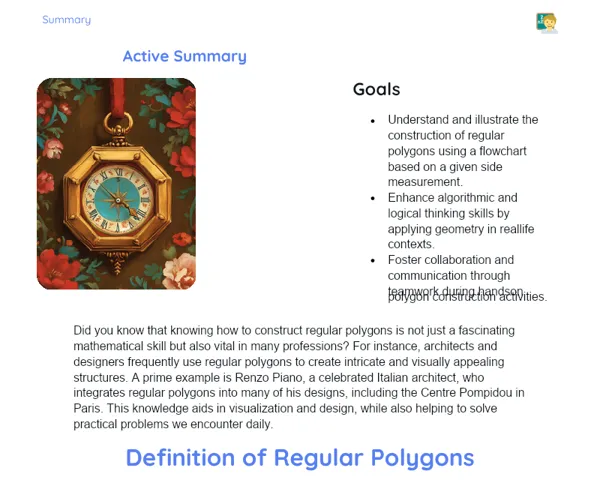Socioemotional Summary Conclusion
Goals
1. Understand the concept of translation of planar figures and how their properties stay the same when moved.
2. Develop the ability to recognize and draw translated figures, focusing primarily on triangles.
3. Explore how translations apply in everyday scenarios, such as in graphic design and architecture.
Contextualization
Did you know that rearranging furniture in your home or adjusting text and images in a presentation involves a mathematical concept called translation? 😲✨ When we translate figures, their characteristics remain unchanged – they only change position! Isn't that fascinating? Let's find out together how this works, and how you may be using this skill without even realising it! 🏠📐
Exercising Your Knowledge
Definition of Translation
Translation is a geometric transformation that moves every point of a figure in the same direction and for the same distance. This transformation does not change the size, shape, or orientation of the figure; it only alters its location on the plane. It’s like sliding the figure smoothly from one spot to another while keeping all its attributes intact. 🚀
-
🔹 Uniform Movement: All points of the figure shift the same distance and direction.
-
🔹 Unchanged Properties: After translation, the size, shape, and orientation of the figure are retained.
-
🔹 Sliding: Picture moving a puzzle piece from its original spot to a new one - the translated figure remains exactly like the original.
Properties of Translation
In translation, the original figure and the translated figure are congruent. This indicates that they possess the same size and shape, albeit in different positions on the plane. Understanding these properties is essential for applying them accurately in both mathematical problems and real-world situations. 🎨
-
🔹 Congruence: The translated figure is the same as the original figure in size and shape.
-
🔹 Different Positions: Even though both figures are identical, they exist in different positions in space.
-
🔹 Practical Applications: From rearranging furniture in your home to aligning design elements, translation is commonly used.
Translation Vectors
Translation vectors are mathematical tools that describe how a figure is displaced. They are represented as an ordered pair (a, b), where 'a' signifies horizontal movement and 'b' represents vertical movement. These vectors inform us precisely how to shift the figure from its original to translated position. ✏️
-
🔹 Ordered Pair: Notated as (a, b), where 'a' indicates horizontal movement and 'b' indicates vertical movement.
-
🔹 Precise Displacement: Provides the exact measures for horizontal and vertical shifts needed to translate the figure.
-
🔹 Essential Tool: Vital for solving translation problems accurately and efficiently.
Key Terms
-
Translation: Movement of a figure in a consistent direction and distance.
-
Congruence: The property of figures that are equal in size and shape.
-
Translation Vector: Ordered pair that indicates the horizontal and vertical shift of a figure.
For Reflection
-
🌟 Reflection 1: How did it feel to work in a group during the translation activity? What emotions came up, and how did you manage them?
-
🌟 Reflection 2: Consider a daily scenario where you apply translation unconsciously. How can grasping this mathematical concept enhance your problem-solving skills in everyday life?
-
🌟 Reflection 3: How can the teamwork and communication skills gained in this lesson be utilized in other aspects of your life, both in academics and personally?
Important Conclusions
-
Throughout this lesson, we explored the idea of translation of planar figures, recognising that their characteristics remain stable despite movement. 🔄
-
We've learned to identify and draw translated figures, particularly through the example of triangles. 📐
-
We discovered the diverse practical applications of translation in our daily activities, including graphic design and architecture. 🎨🏛️
Impacts on Society
Understanding the translation of planar figures is an essential skill not only in mathematics but also in various aspects of daily life. For instance, when you move furniture in your room, you are employing translation concepts to optimise your layout. Similarly, graphic designers utilise this concept daily to arrange elements in their projects, ensuring the final layout is both appealing and practical. 📦🪑 Moreover, mastering translations can bolster your confidence in problem-solving and tackling challenges. By recognising that you can shift figures without altering their properties, you can start thinking of ways to adjust personal and academic situations for improved outcomes. This capacity for adjustment and adaptability is crucial for developing resilience and effectiveness in different contexts. 🌟
Dealing with Emotions
To handle your emotions while studying translations, you can employ the RULER method. Start by recognizing when you feel anxious or frustrated. Understand that these feelings may stem from temporary challenges. Name these emotions correctly, like 'frustration' or 'satisfaction'. Express your feelings appropriately, whether by discussing them with peers or jotting them down in a journal. Finally, regulate your emotions through breathing exercises or short breaks to help maintain focus and calm while studying.
Study Tips
-
📖 Practice Regularly: Create various figures and apply translation vectors to observe their movement. Make use of graph paper for accuracy.
-
👥 Study in Groups: Collaborating with classmates can help deepen your understanding of the concept and clear up any confusion. You can also share ideas and study techniques.
-
💻 Use Technology: Explore digital geometry apps to engage in interactive translation exercises. These resources can turn learning into a more dynamic and enjoyable experience.


